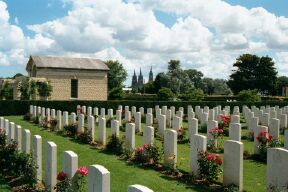
BAYEUX WAR CEMETERY

| British - 3,935 Canadian - 181 Australian - 17 New Zealand - 8 South African - 1 Polish - 25 France - 3 Czech - 2 Italian - 2 Russian - 7 German - 466 Unidentified - 1 |
HISTORICAL INFORMATION: Bayeux was entered by the Sherwood Rangers late on 6th June 1944, but was formally liberated the next day. Charles de Gaulle established is first seat of government here until Paris was liberated, and it became the main staging post for the British Army in Normandy. The streets of Bayeux were too narrow for most military vehicles, and so the Royal Engineers and Pioneer Corps constructed a ring-road round Bayeux soon after D Day. Several military hospitals were established here, and many of the burials in the cemetery are from these.
LOCATION: The cemetery lies on the south-west side of the main ring road (built by the British in 1944) around the city of Bayeux. It is about 100 metres from the junction with the D5 to Littry, and almost opposite the Museum of the Battle of Normandy (which is well signposted throughout Bayeux).
PERSONALITIES: The largest British military cemetery of the Second World War in France, the original graves were of soldiers who died of wounds in the military hospitals at Bayeux. After WW2 graves were moved in from all over the Normandy battlefields, many of them isolated burials.
One of the few Normandy VC winners is buried here. Corporal Sidney Bates was serving with the Norfolks when he took part in action at Sourdeval in August 1944, which resulted in the posthumous award of the Victoria Cross. From Camberwell, in London, Bates was badly wounded in the action, dying of his wounds the next day. His citation reads:
"In North-West Europe on 6th August, 1944, the position held by a battalion of the Royal Norfolk Regiment near Sourdeval was heavily attacked. Corporal Bates was commanding a forward section of the left forward company which suffered some casualties, so he decided to move the remnants of his section to an alternative position from which he could better counter the enemy thrust. As the threat to this position became desperate, Corporal Bates seized a light machine-gun and charged, firing from the hip. He was almost immediately wounded and fell, but he got up and advanced again, though mortar bombs were falling all round him. He was hit a second time and more seriously wounded, but he went forward undaunted, firing constantly till the enemy started to fall back before him. Hit for the third time, he fell, but continued firing until his strength failed him. By then the enemy had withdrawn and Corporal Bates, by his supreme gallantry and self-sacrifice, had personally saved a critical situation. He died shortly afterwards of the wounds he had received."
ŠPaul Reed 2002-2006
![]()